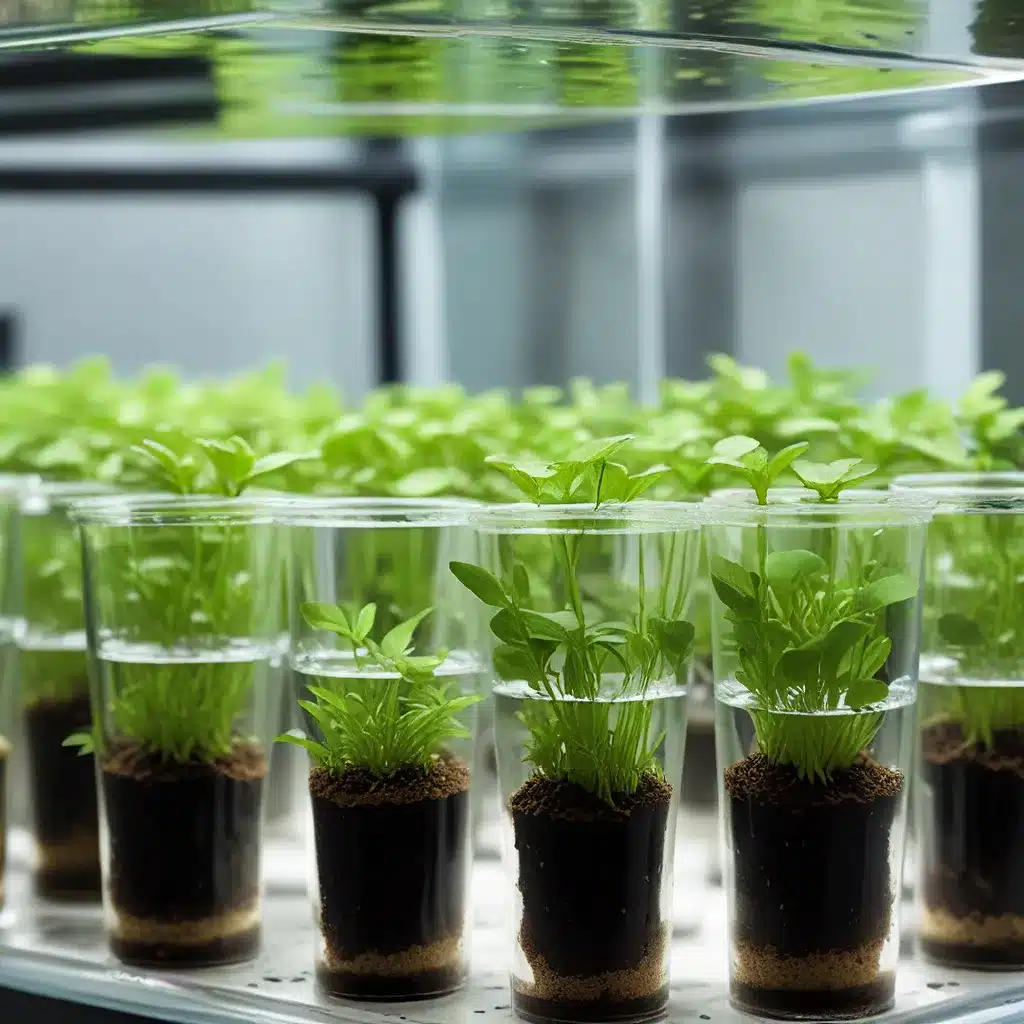
Understanding Tissue Culture Propagation
Tissue culture propagation is a cutting-edge technique that allows aquarium enthusiasts to grow high-quality, disease-free aquatic plants from small plant fragments. This specialized method involves cultivating plant tissues in a sterile, controlled environment, providing the perfect conditions for rapid, uniform growth. By leveraging tissue culture, aquarists can efficiently propagate rare or challenging-to-find plant species, ensuring a steady supply of healthy, vibrant vegetation for their aquariums.
One of the primary benefits of tissue culture propagation is the ability to produce plants that are genetically identical to the parent specimen. This is particularly valuable for aquarists seeking to replicate a specific aquascaping layout or maintain the visual cohesion of their underwater garden. Moreover, tissue-cultured plants are often more resilient and less prone to pests or diseases compared to plants propagated through traditional methods, such as cuttings or divisions.
The tissue culture process typically involves several key steps, including sterilization, nutrient-rich media preparation, and aseptic cultivation. By carefully controlling these parameters, aquarists can cultivate robust, thriving plants that can be easily integrated into their aquarium setups.
Preparing for Tissue Culture Propagation
Before embarking on a tissue culture project, it’s essential to ensure that you have the necessary equipment and supplies. This may include:
- Sterile workspace: A clean, well-ventilated area, such as a laminar flow hood or a sterilized workbench, is crucial for maintaining a sterile environment.
- Sterilization equipment: Items like pressure cookers, autoclave, or chemical sterilization solutions are required to disinfect plant materials and culture media.
- Tissue culture vessels: Specialized containers, such as culture jars or Petri dishes, designed to provide a controlled, sealed environment for plant growth.
- Nutrient-rich media: Carefully formulated agar-based or liquid growth media that provide the essential nutrients and hormones for plant development.
- Plant materials: Healthy, disease-free plant fragments or explants to be used as the starting material for tissue culture propagation.
Once you have the necessary equipment and supplies, it’s time to begin the tissue culture process.
The Tissue Culture Process
-
Preparing the Plant Explants: The first step in tissue culture propagation is to obtain healthy, disease-free plant materials. This may involve carefully selecting and cleaning plant fragments or taking small cuttings from a thriving aquarium plant.
-
Surface Sterilization: To prevent contamination, the plant explants must undergo a thorough surface sterilization process. This may involve soaking the plant materials in a diluted bleach solution, followed by rinses with sterile water.
-
Media Preparation: The nutrient-rich media used for tissue culture is typically agar-based or liquid, formulated with essential vitamins, minerals, and plant growth hormones. This media is then sterilized, often using an autoclave or pressure cooker, to ensure a sterile environment for plant growth.
-
Inoculation and Cultivation: Under aseptic conditions, the sterilized plant explants are carefully transferred to the sterile culture vessels filled with the prepared media. These vessels are then sealed and placed in a dedicated growth chamber or incubator, where they can thrive in a controlled, sterile environment.
-
Monitoring and Maintenance: Throughout the tissue culture process, the growing plants must be closely monitored for any signs of contamination or abnormal growth. Regular checks and, if necessary, the addition of fresh media or transplanting of the plantlets, are crucial for ensuring the health and viability of the tissue-cultured specimens.
-
Acclimatization and Transplanting: Once the plants have reached a suitable size and development stage, they can be carefully removed from the tissue culture vessels and gradually acclimated to the conditions of a traditional aquarium or terrarium setup. This process, known as hardening off, helps the plants adapt to the new environment and thrive in their final destination.
Benefits of Tissue Culture Propagation
Tissue culture propagation offers numerous advantages for aquarium enthusiasts, including:
- Rapid Plant Growth: The controlled, sterile environment of tissue culture allows plants to grow at an accelerated rate, often outpacing traditional propagation methods.
- Disease and Pest-Free Plants: Tissue-cultured plants are less susceptible to pests and diseases, as the propagation process eliminates potential pathogens.
- Genetic Consistency: By propagating from a single parent plant, tissue culture ensures that the resulting plants are genetically identical, making it easier to maintain a cohesive aquascaping layout.
- Rare and Challenging Species: Tissue culture techniques enable the successful propagation of rare or difficult-to-grow aquatic plant species, expanding the options available to aquarists.
- Sustainability: Tissue culture propagation reduces the need for wild collection or unsustainable harvesting of aquatic plants, promoting more environmentally conscious aquarium practices.
Incorporating Tissue-Cultured Plants into Your Aquarium
When introducing tissue-cultured plants into your aquarium, it’s important to carefully acclimate them to the new environment. This gradual transition process helps the plants adapt to the water parameters, lighting, and other conditions of your aquarium setup.
Start by floating the tissue-cultured plants in the aquarium for several hours, allowing them to adjust to the temperature and water chemistry. Then, gradually add small amounts of aquarium water to the culture vessel, allowing the plants to slowly acclimate to the new conditions.
Once the plants have been successfully integrated into your aquarium, you can enjoy the vibrant, healthy vegetation and the satisfaction of having propagated them yourself using the cutting-edge technique of tissue culture.
Remember, maintaining a healthy, thriving aquarium ecosystem requires a combination of proper water management, adequate lighting, and the careful selection and cultivation of aquatic plants. By incorporating tissue-cultured plants into your aquarium, you can take your aquascaping skills to new heights and create truly stunning underwater landscapes.
For more information on tissue culture propagation, visit King Aquarium for expert advice and a wide selection of tissue-cultured aquatic plants to enhance your aquarium.

